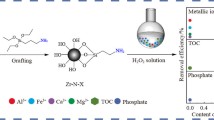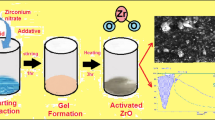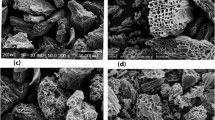Abstract
This study investigated the room temperature adsorptive removal of thiophene over zinc oxide adsorbents in the presence of hydrogen. The bulk zinc oxide was prepared by precipitation method and calcined at different temperatures in the range of 300-550 °C. Supported zinc oxide was prepared by co-precipitation of 30 wt.% ZnO with alumina and calcined at 550 °C. Properties of the adsorbents were determined by various characterization techniques such as surface area and pore volume analysis, XRD, FESEM, EDX and TPR. The desulfurization process was carried out in a down-flow packed bed reactor at room temperature (30 °C). The BET surface area of bulk zinc oxide adsorbents decreased with the increase in calcination temperature from 300 to 550 °C. The surface area of bulk zinc oxide adsorbents was 30.5 and 14.6 m2/g when calcined at 300 and 550 °C, respectively. The surface are of supported zinc oxide adsorbents was 177 m2/g. The highest average pore size was obtained for bulk ZnO calcined at 550 °C (45 nm) compared to that calcined at 300 °C (42 nm) and supported ZnO (27 nm). The XRD peaks corresponded to the hexagonal structure of zinc oxide. The removal of thiophene was most significant for bulk ZnO calcined at 550 °C. The higher removal efficiency for this adsorbent in spite of lower surface area may be attributed to its higher percentage of larger pores and higher average pore size.








Similar content being viewed by others
References
H. Maldonado, A.J. Stamatis, S.D. Yang, R.T. He, and A.Z. Cannella, New Sorbents for Desulfurization of Diesel Fuels via π Complexation Layered Beds and Regeneration, Ind. Eng. Chem. Res., 2004, 43, p 769-776
C. Song, An Overview of New Approaches to Deep Desulfurization for Ultra-Clean Gasoline Diesel Fuel and Jet Fuel, Catal. Today, 2003, 86, p 211-263
C. Song and X. Ma, Adsorptive Desulfurization of Diesel Fuel over a Metal Sulfide-Based Adsorbent, Div. Fuel Chem., 2003, 48, p 522
I.V. Babich and J.A. Moulijn, Science and Technology of Novel Processes for Deep Desulfurization of Oil Refinery Streams, Fuel, 2003, 82, p 607-631
P. Baeza, G. Aguila, F. Gracia, and P. Araya, Desulfurization by Adsorption with Copper Supported on Zirconia, Catal. Commun., 2008, 9, p 751-755
E.L. Sughrue, G.P. Khare, B.J. Bertus, M.M. Johnson, Desulfurization and Novel Sorbents for Same, U.S. Patent 6254766, 2001
R.T. Yang, Adsorbents: Fundamentals and Applications, Wiley, New York, 2003
A.J. Hernández-Maldonado and R.T. Yang, Desulfurization of Diesel Fuels via π-Complexation with Nickel (II)-Exchanged X- and Y Zeolites, Ind. Eng. Chem. Res., 2004, 43, p 1081-1089
A. Bösman, L. Datsevich, A. Jess, A. Lauter, C. Schmitz, and P. Wasserscheid, Deep Desulfurization of Diesel Fuel by Extraction with Ionic Liquids, Chem. Commun., 2001, 0, p 2494-2495. https://doi.org/10.1039/B108411A
K. Tawara, T. Nishimura, H. Iwanami, T. Nishimoto, and T. Hasuike, New Hydrodesulfurization Catalyst for Petroleum-Fed Fuel Cell Vehicles and Cogenerations, Ind. Eng. Chem. Res., 2001, 40, p 2367-2370
K. Tawara, T. Nishimura, and H. Iwanami, Ultra-deep Hydrodesulfurization of Kerosene for Fuel Cell System, Sekiyu Gakkaishi, 2000, 43, p 105-113
Y. Yang, Y. Zhang, L. Wang, Y. Zhang, Z. Jiang, and C. Li, Ultra Deep Adsorptive Desulfurization of Solvent Oils by Ni/ZnO Adsorbent, Petrochem. Technol., 2008, 37, p 243-246
I. Bezverkhyy, A. Ryzhikov, G. Gadacz, and J.P. Bellat, Kinetics of Thiophene Reactive Adsorption on Ni/SiO2 and Ni/ZnO, Catal. Today, 2008, 130, p 199-205
I. Bezverkhyy, O.V. Safonova, P. Afanasiev, and J.P. Bellat, Reaction Between Thiophene and Ni Nanoparticles Supported on SiO2 or ZnO In Situ Synchrotron X-Ray Diffraction Study, J. Phys. Chem. C, 2009, 113, p 17064-17069
C. Caddeo, G. Malloci, G.M. Rignanese, L. Colombo, and A. Mattoni, Electronic Properties of Hybrid Zinc Oxide-Oligothiophene Nanostructures, J. Phys. Chem. C, 2012, 116, p 8174-8180
M. Xue, R. Chitrakar, K. Sakane, T. Hirotsu, K. Ooi, Y. Yoshimura, M. Toba, and Q. Fengb, Preparation of Cerium-Loaded Y-Zeolites for Removal of Organic Sulfur Compounds from Hydrodesulfurizated Gasoline and Diesel Oil, J. Colloid Interface Sci., 2006, 298, p 535-542
S.H. Kang, J.W. Bae, H.T. Kim, K.W. Jun, S.-Y. Jeong, and K.V.R. Chary, Effective Removal of Odorants in Gaseous Fuel for the Hydrogen Station Using Hydrodesulfurization and Adsorption, Energy Fuels, 2007, 213, p 537-3540
J. Shangguan, Y. Zhao, H. Fan, L. Liang, F. Shen, and M. Miao, Desulfurization Behavior of Zinc Oxide Based Sorbent Modified by the Combination of Al2O3 and K2CO3, Fuel, 2013, 108, p 80-84
P. Dhage, A. Samokhvalov, D. Repala, E.C. Duinc, and B.J. Tatarchuka, Regenerable Fe-Mn ZnO/SiO2 Sorbents for Room Temperature Removal of H2S from Fuel Reformates: Performance, Active Sites, Operando Studies, Phys. Chem. Chem. Phys., 2011, 13, p 2179-2187
T. Jirsak, J. Dvorak, and J.A. Rodriguez, Chemistry of Thiophene on ZnO, S/ZnO, and Cs/ZnO Surfaces: Effects of Cesium on Desulfurization Processes, J. Phys. Chem. B, 1999, 103, p 5550-5559
K.S.W. Sing, D.H. Everett, R.A.W. Haul, L. Moscou, R.A. Pierotti, J. Rouquerol, and T. Siemieniewska, Reporting Physisorption Data for Gas/Solid Systems with Special Reference to the Determination of Surface Area and Porosity, Pure Appl. Chem., 1985, 57, p 603-619
S. Rane, O. Borg, J. Yang, E. Rytter, and A. Holmen, Effect of Alumina Phases on Hydrocarbon Selectivity in Fischer–Tropsch Synthesis, Appl. Catal. A, 2010, 388, p 160-167
K. Ebitani and H. Hattori, Combined Temperature-Programmed Reduction (TPR)-Temperature-Programmed Desorption (TPD) Study of Supported Platinum Catalysts, Bull. Chem. Soc. Jpn., 1991, 64, p 2422-2427
A. Ryzhikov, I. Bezverkhyy, and J.P. Bellat, Reactive Adsorption of Thiophene on Ni/ZnO: Role of Hydrogen Pretreatment and Nature of the Rate Determining Step, Appl. Catal. B Environ., 2008, 84, p 766-772
Author information
Authors and Affiliations
Corresponding author
Additional information
This article is an invited paper selected from presentations at “ICETINN-2017, International Conference on Emerging Trends in Nanoscience and Nanotechnology,” held March 16-18, 2017, in Majitar, Sikkim, India, and has been expanded from the original presentation.
Electronic supplementary material
Below is the link to the electronic supplementary material.
Rights and permissions
About this article
Cite this article
Singh, S.B., De, M. Room Temperature Adsorptive Removal of Thiophene over Zinc Oxide-Based Adsorbents. J. of Materi Eng and Perform 27, 2661–2667 (2018). https://doi.org/10.1007/s11665-018-3192-2
Received:
Revised:
Published:
Issue Date:
DOI: https://doi.org/10.1007/s11665-018-3192-2




